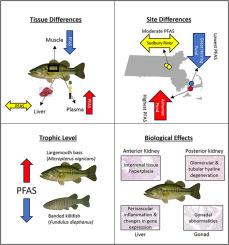美国马萨诸塞州点源和非点源水体中全氟烷基和多氟烷基物质(PFAS)在鱼类中的发生和组织分布
IF 4.3
2区 环境科学与生态学
Q1 MARINE & FRESHWATER BIOLOGY
引用次数: 0
摘要
全氟和多氟烷基物质(PFAS)是持久性环境污染物,在水生生态系统中具有已知的生物累积和毒性作用。本研究评估了来自马萨诸塞州阿舒梅塘、萨德伯里河和大鲱鱼塘(参考地点)的鱼类中PFAS污染的具体地点差异。来自Ashumet池塘的鱼显示出最高的全氟辛烷磺酸浓度,特别是全氟辛烷磺酸(PFOS),其血浆浓度几乎是参考地点的650倍。主成分分析确定了每个站点不同的PFAS概况,反映了局部污染源。阿舒梅池塘的时间分析显示,从2020年到2022年,血浆中全氟辛烷磺酸和全氟癸酸(PFDA)大幅增加。组织分布分析显示,血浆中PFAS浓度最高,其次是肝脏和肌肉,这与PFAS与血液蛋白的结合亲和力一致。观察到PFAS生物积累的物种特异性差异,黑鲈(Micropterus nigricans)比带状鳉鱼(Diaphanus fundulus)表现出更高的身体负担,可能是由于营养位置和饮食暴露所致。组织病理学评估和基因转录分析显示PFAS暴露与炎症反应、氧化应激、内分泌干扰和免疫相关途径之间存在关联,在萨德伯里河下游观察到最明显的分子效应。这项研究强调了了解PFAS在鱼类中的特定污染源、暴露途径和生物学效应的重要性。这些发现将受益于沉积物污染的进一步研究、每个位点的时间分析、营养转移和跨多个器官的转录组分析,以进一步阐明PFAS的毒性机制并指导修复工作。本文章由计算机程序翻译,如有差异,请以英文原文为准。

Occurrence and tissue distribution of per- and polyfluoroalkyl substances (PFAS) in fishes from waterbodies with point and non-point sources in Massachusetts, USA
Per- and polyfluoroalkyl substances (PFAS) are persistent environmental contaminants with known bioaccumulative and toxic effects in aquatic ecosystems. This study assessed site-specific differences in PFAS contamination in fish from Ashumet Pond, Sudbury River, and Great Herring Pond (reference site) in Massachusetts. Fish from Ashumet Pond exhibited the highest PFAS concentrations, particularly perfluorooctane sulfonate (PFOS), which exceeded levels in plasma almost 650 times those at the reference site. Principal component analysis identified distinct PFAS profiles at each site, reflecting localized contamination sources. Temporal analysis at Ashumet Pond revealed a substantial increase in plasma PFOS and perfluorodecanoic acid (PFDA) from 2020 to 2022. Tissue distribution analyses showed the highest PFAS concentrations in plasma, followed by liver and muscle, consistent with PFAS binding affinity for blood proteins. Species-specific differences in PFAS bioaccumulation were observed, with largemouth bass (Micropterus nigricans) exhibiting higher body burdens than banded killifish (Diaphanus fundulus), likely due to trophic position and dietary exposure. Histopathological assessments and gene transcript analyses revealed associations between PFAS exposure and inflammatory responses, oxidative stress, endocrine disruption, and immune-related pathways, with the most pronounced molecular effects observed at the downstream site of the Sudbury River. This study underscores the importance of understanding site-specific contamination sources, exposure pathways, and biological effects of PFAS in fish. These findings would benefit from additional research on sediment contamination, temporal analyses at each site, trophic transfer, and transcriptomic analyses across multiple organs to further elucidate PFAS toxicity mechanisms and guide remediation efforts.
求助全文
通过发布文献求助,成功后即可免费获取论文全文。
去求助
来源期刊

Aquatic Toxicology
环境科学-毒理学
CiteScore
7.10
自引率
4.40%
发文量
250
审稿时长
56 days
期刊介绍:
Aquatic Toxicology publishes significant contributions that increase the understanding of the impact of harmful substances (including natural and synthetic chemicals) on aquatic organisms and ecosystems.
Aquatic Toxicology considers both laboratory and field studies with a focus on marine/ freshwater environments. We strive to attract high quality original scientific papers, critical reviews and expert opinion papers in the following areas: Effects of harmful substances on molecular, cellular, sub-organismal, organismal, population, community, and ecosystem level; Toxic Mechanisms; Genetic disturbances, transgenerational effects, behavioral and adaptive responses; Impacts of harmful substances on structure, function of and services provided by aquatic ecosystems; Mixture toxicity assessment; Statistical approaches to predict exposure to and hazards of contaminants
The journal also considers manuscripts in other areas, such as the development of innovative concepts, approaches, and methodologies, which promote the wider application of toxicological datasets to the protection of aquatic environments and inform ecological risk assessments and decision making by relevant authorities.
 求助内容:
求助内容: 应助结果提醒方式:
应助结果提醒方式:


